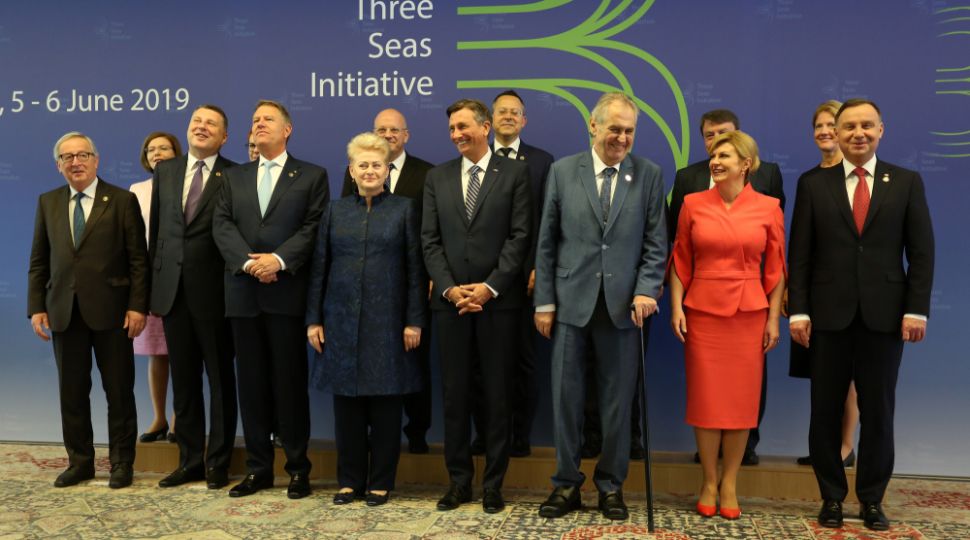Germany and the Three Seas Initiative

The Evolution of Germany’s Position on the TSI
Germany has seen the TSI as a project to consolidate divisions in the EU. After TSI was inaugurated in 2016, the Germans partly viewed Central Europe through the prism of EU institutions’ criticism of Poland, a co-founder of the TSI, and Hungary, Poland’s closest ally in disputes with the Union, over rule-of-law matters. Further concerns were raised at the same time by the difference in positions within the Visegrad Group (Czech Republic, Hungary, Poland, Slovakia) on reform of the EU’s migration and asylum policy.
In the eyes of Germany, the TSI took on a new dimension when the U.S. became interested in it, especially after the participation of President Donald Trump in the 2017 Warsaw summit. The German government negatively assessed Trump’s policy toward Europe. From its perspective, Trump began to treat Europe not as a partner but as a competitor, manifested by the president’s ambiguous approach to the role of NATO, the suspension of negotiations on the Transatlantic Trade and Investment Partnership, the U.S. exit from the Paris Agreement on climate, and the conflict with the EU over Iran. U.S. criticism of Nord Stream 2 and Germany’s defence spending below the 2% NATO goal added to the concerns. As a consequence, Germany began to fear that the TSI would become a tool of U.S. influence in the eastern part of the Union, used for increasing its economic presence, in part through imports of U.S. gas.
In the German perception of the TSI, the evolution of the concept itself was not without significance. The Warsaw summit declaration explicitly indicated that one of the initiative's goals was to strengthen and consolidate EU unity. In addition, TSI contributing countries not only raised the priority of transport connections but also highlighted the projects’ synergy with EU activities and—particularly important from the German perspective—the promotion of the business nature of joint economic projects. This represented both a potential opportunity for German companies and a threat from the possibility of China’s greater economic involvement in Central Europe.
The change in approach to the TSI was ultimately determined by the reconstruction of the German government after the parliamentary elections in September 2017. The new Social Democratic Foreign Minister Heiko Maas in June 2018 presented the concept of “a new European Eastern policy”. Among other things, it assumes an increasing German diplomatic commitment in Central Europe. Chancellor Angela Merkel has not publicly responded to the TSI.
Germany as a TSI Observer
Part of the implementation of Maas’s new foreign policy guidelines was his participation in the TSI summit in Bucharest in September 2018. Germany wanted to signal that it had noticed the interests and priorities of the TSI countries. At the same time, involvement in the summit was intended to allow it to gain insight into the internal workings of the TSI and to balance the role of the U.S., which had participated in the annual meetings.
Germany’s status as a partner country was included in the final declaration of the Bucharest summit, but since it was not formally defined, in practice it means it has the role of an observer. The U.S., the European Commission, the European Investment Bank, the European Bank for Reconstruction and Development, and the World Bank have the same status. Although Germany itself applied for participation with this status, Maas during the summit suggested that as a Baltic state it should become a member. Although Romanian President Klaus Iohannis expressed at the Bucharest summit his support for German membership the other TSI members did not take it up, so there was no change.
German President Frank-Walter Steinmeier's visit to Ljubljana in 2019 raised the rank of the German delegation compared to the previous summit. He took part only in the gala dinner, leaving German Ministry of Foreign Affairs staffers to represent Germany in the political discussions and business forum. Although Deputy Minister Andreas Michaelis suggested that the president's participation was a sign of progress towards Germany’s “full-fledged participation” in the TSI, the summit’s final declaration confirmed its status as a partner country only.
The Importance of Central Europe Infrastructure
Participation in the TSI summits as an observer does not give Germany the opportunity to influence the direction and priorities of infrastructure development in the region. At the same time, the initiative has just started to create instruments to directly support the implementation of its projects—the Three Seas Fund and the business forum. The interest of German businesses (e.g., Deutsche Bahn, Airbus, Siemens) was evident in the Lublin edition of the forum.
For Germany, the effects of developing transport connections in Central Europe in the north-south direction may have a net benefit for it. Germany is a key trading partner of most TSI countries (except Lithuania, Latvia, and Estonia). For Germany, the Visegrad Group has been more important in terms of trade (with exchange volume of €293.1 billion in 2018) than China (€199.3 billion), the U.S. (€177.8 billion), or France (€170.5 billion). Also contributing to the German position are the numerous elements that feed German industry, which could indirectly benefit from the implementation of the planned infrastructure projects. At the Ljubljana summit’s business forum, German representatives signalled their interest in Rail Baltica’s project connecting the Baltic States with Poland by rail and, ultimately, also with Germany as part of the TEN-T North Sea-Baltic Sea route. At the same time, Germany sees projects that may weaken its role as a transit country, such as the Polish ports on the Baltic Sea. For example, in 2017, carmakers KIA and Hyundai moved some exports from their factories in the Czech Republic and Slovakia from German and Belgian ports to Gdansk’s. The expansion of connections between Poland’s Baltic ports and the region could intensify such processes.
Conclusions and Perspectives
From the point of view of the countries that make up the TSI, Germany’s support for this project and its participation in the summits confirms the initiative’s complementarity with EU activity. Although President of the European Commission Jean-Claude Juncker attended the summits in Bucharest and Ljubljana, indicating support of the TSI from EU institutions, the participation of Germany, the largest EU Member State, further strengthens the initiative.
Germany presents its involvement in the TSI as an intensification of the dialogue and cooperation with the eastern part of the EU. This is part of a policy intended to strengthen EU coherence towards non-European powers, primarily the U.S., but also China. The issue of the divergence of German and U.S. interests around Nord Stream 2—which initially affected the former’s perception of the TSI—was not discussed within the initiative despite the varied positions amongst its members towards the pipeline project. Austria, the Czech Republic, and Slovakia support it while Poland, the Baltic States, Croatia, Romania, and Slovenia oppose it. This attitude from Germany may suggest that it will not raise other contentious issues in the TSI forum.
If the infrastructure goals in Central Europe are achieved through TSI cooperation—and not by individual countries outside the initiative—Germany may intensify its efforts to gain membership. For Germany, this would not result in either additional political risk, assuming further confirmation of TSI’s complementarity with EU activities, or financial risk, given the voluntary and so-far modest participation of initiative countries in the Three Seas Fund. On the other hand, Germany would gain the major benefit of being able to influence the debate on the development of some infrastructure elements in Central Europe. However, due to the nature of the TSI, among other things, aiming to tighten cooperation among its member states in order to reduce economic differences between the western and eastern parts of the EU, there is no indication that there will be a change in Germany’s status for now.


